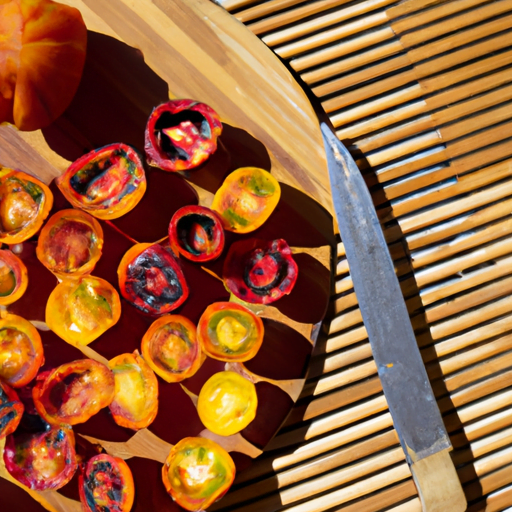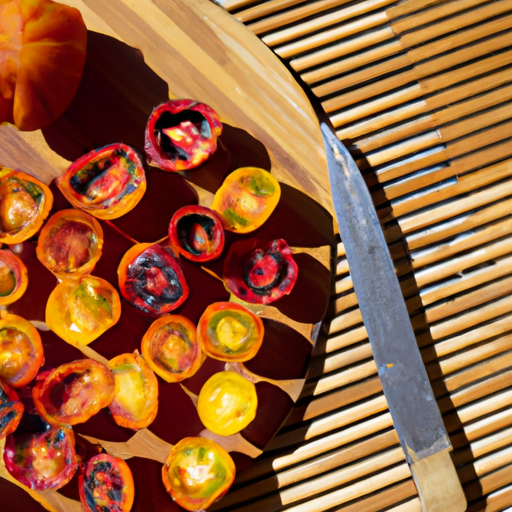Have you ever wondered how people who live off the grid preserve their food without the use of modern appliances? Well, one method that has been used for centuries is the sun drying method. This traditional technique allows individuals to dry and preserve food using only the power of the sun. In this article, we’ll dive into the details of the sun drying method and explore how it can be used as an effective and sustainable way to store food.
Sun drying, as the name suggests, involves exposing food to the sun’s rays in order to remove moisture and inhibit the growth of bacteria and other microorganisms. This method has been utilized by different cultures across the globe for centuries, with fruits, vegetables, and meats being commonly dried using this technique. By dehydrating the food, its shelf life can be significantly extended, making it an ideal method for those living off the grid or in areas with limited access to electricity.
The sun drying method is a relatively simple process. First, the food that needs to be dried is washed and prepared. Then, it is placed on racks or trays and arranged in a location where it can get direct sunlight. The food is left to dry for several days or even weeks, depending on the type of food being dried and the weather conditions. Over time, the sun’s heat evaporates the moisture in the food, leaving it dehydrated and preserved.
In the upcoming article, we will explore the benefits of the sun drying method and provide tips on how to properly sun dry food to ensure its safety and longevity. Whether you are interested in learning more about off grid living or simply want to try your hand at a sustainable food preservation technique, the sun drying method may just be the solution you’re looking for. Stay tuned to discover the ins and outs of this ancient practice and how you can incorporate it into your own lifestyle. Sun drying method is a traditional technique of preserving food by using the heat and energy of the sun. It is a simple and cost-effective way to extend the shelf life of fruits, vegetables, meat, and fish. This method has been used for centuries and has gained significance due to its numerous benefits. In this article, we will delve deeper into the basics of sun drying, how it works, and the varieties of foods suitable for sun drying.
Sun drying is the process of dehydrating food items by exposing them to the sun’s heat and air. It is a natural technique that eliminates moisture from food, making it less prone to spoilage. Historically, sun drying was a common method of food preservation in many cultures and was especially utilized in regions where access to refrigeration or other preservation methods was limited. Even in modern times, sun drying is widely practiced in various parts of the world.
The goal of sun drying is to remove as much water content from the food as possible. This reduction in moisture inhibits the growth of microorganisms, thus preventing spoilage. Traditional sun drying techniques involve laying the food items on open racks or mats and exposing them to direct sunlight. However, modern methods often utilize specially designed solar dryers to optimize the drying process.
Sun drying has a significant historical significance as it was one of the earliest methods of food preservation. Throughout history, ancient civilizations such as the Egyptians, Greeks, and Romans relied on sun drying to store surplus food for later consumption. In addition to preservation, sun drying was also influenced by cultural practices and beliefs. For instance, in some cultures, sun-dried foods were considered sacred or were used in ceremonial rituals.
There are various foods that are suitable for sun drying. Fruits, such as grapes, apples, and figs, are commonly sun dried to produce raisins, dried apples, and dried figs. Vegetables like tomatoes, peppers, and mushrooms can also be dried under the sun. In addition, meat and fish can be effectively preserved by sun drying, resulting in products like beef jerky and dried fish.
Now, let’s delve into how sun drying works. The process of sun drying involves three main steps: preparation of food, arrangement for drying, and sun exposure. First, the food is prepared by washing, peeling, and slicing if necessary. Some foods may require blanching or pre-treatment to preserve their color or texture. Once prepared, the food is arranged in a single layer on drying racks or mats, ensuring proper air circulation.
The drying racks are then placed in an open area with maximum exposure to sunlight. It is important to rotate the food periodically to ensure even drying. The duration of sun drying depends on various factors, including climate, weather conditions, and food thickness. In ideal conditions, fruits and vegetables may take anywhere from a few days to a week to dry completely, while meat and fish can take longer.
Several factors can affect the drying time during sun drying. Climate and weather conditions play a significant role, as optimal drying happens in hot and dry weather. Food thickness and size also affect the drying time, with thinner slices drying quicker than thicker ones. Humidity and air circulation are crucial as well, as high humidity slows down drying and proper air circulation ensures even drying of the food.
The principle behind sun drying is evaporation. As the food is exposed to the sun’s heat, the water content within the food converts into vapor and evaporates into the air. This evaporation process removes moisture from the food, making it less vulnerable to spoilage. However, it is important to note that sun drying can affect the nutritional content of the food. Some vitamins, such as vitamin C, are sensitive to heat and may be partially lost during the drying process.
In conclusion, understanding the sun drying method is essential for those interested in food preservation or off-grid living. Sun drying is a traditional technique that harnesses the sun’s energy to remove moisture from food and extend its shelf life. It has a rich historical significance and is used to preserve a wide range of foods, including fruits, vegetables, meat, and fish. The process of sun drying involves preparation of food, arrangement for drying, and exposure to sunlight. Various factors, such as climate, food thickness, and air circulation, can affect the drying time. While sun drying is an effective preservation method, it is important to consider its impact on the nutritional content of the food. Overall, sun drying is a sustainable and cost-effective way to preserve food and can be a valuable skill for those seeking self-sufficiency or a more natural approach to food preservation.





